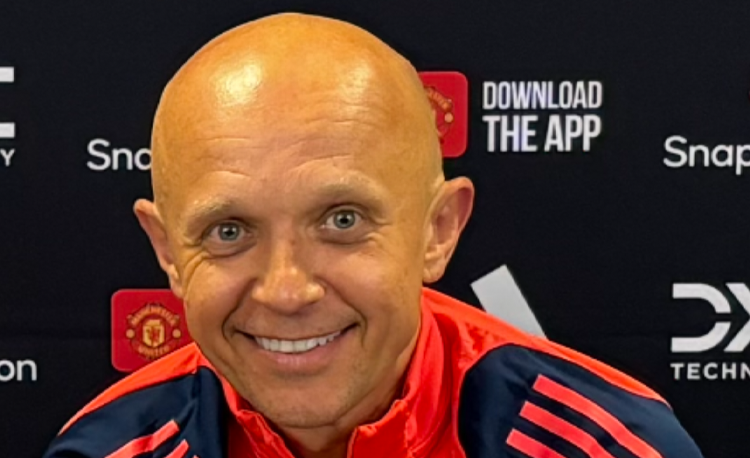You are viewing 1 of your 1 free articles
Passing and effective possession play
The aim of this session is to get players to use effective possession play as a tool to move and disorganise the opposition’s defence and to penetrate successfully with careful forward build up play.
| Area | Up to three-quarters of pitch |
| Equipment | Balls, bibs, cones, 8 mannequins, 2 full size goals |
| No. of Players | 20 players + 2 goalkeepers |
| Session Time |
General warm-up: 4mins, Passing practice: 12mins, Ball possession: 15mins, Thematic game: 25mins, 11v11 game: 20 mins |
The aim of this session is to get players to use effective possession play as a tool to move and disorganise the opposition’s defence and to penetrate successfully with careful forward build up play.
When asked by Elite Soccer to contribute a training plan to the magazine, we chose to present a real training session that was used by Rio Ave in February 2020 as part of our build up to the match against Sporting Lisbon in the Primeira Liga.
The training session corresponds to our match day -3 training session, when we work on endurance.
The focus of the session was also on the evolution of our game ideas for this fixture, including introducing some of our strategic objectives and taking into account the characteristics of the opponents that we were to face.
PASSING PRACTICE
We set up between the penalty boxes on the left hand side of the pitch, with four mannequins on the halfway line. This is a position-specific warm-up and players should be in their respective game positions.
This first diagram, as shown [1a], covers movement on the left of the pitch, so involves players who usually play on that side.
1a
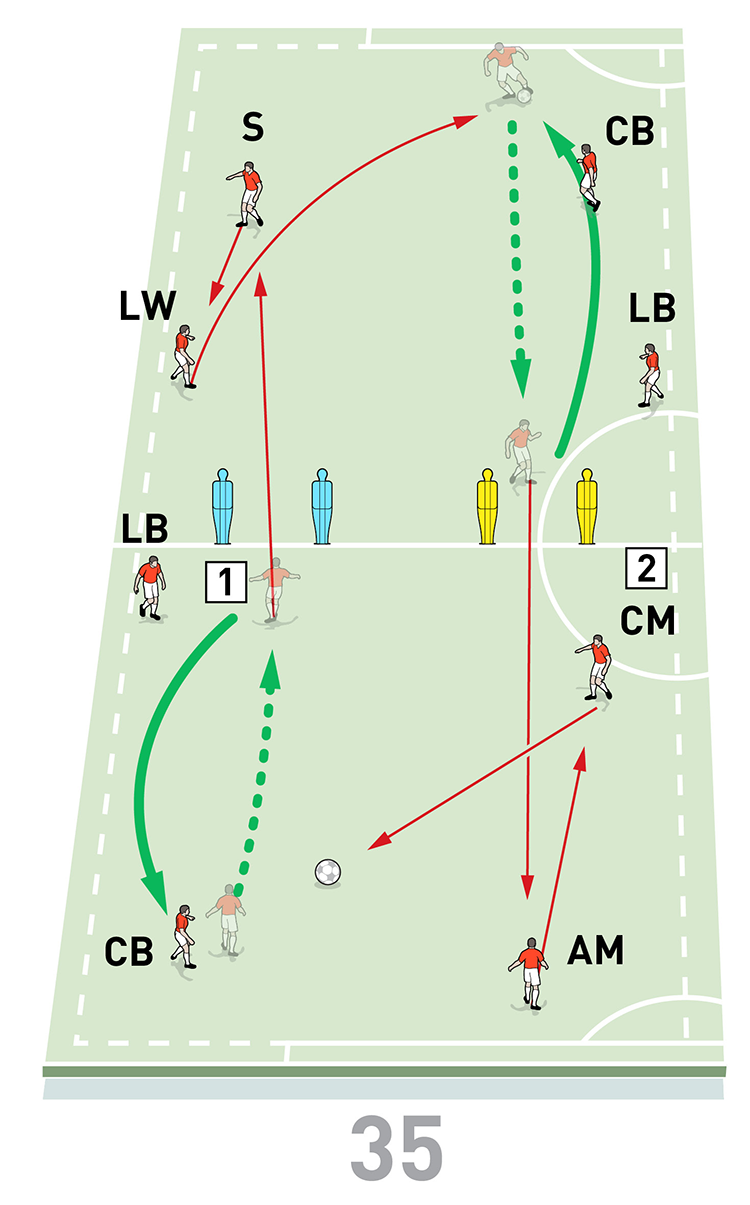
2. Play follows this pattern until the centre midfielder passes to the first centre back and the same sequence is then repeated
The activity follows this sequence:
1. The centre back (CB) drives up the pitch with the ball to just behind the position of the mannequins and then passes through to the striker (S).
2. The striker passes outside to the left winger (LW), who passes back to the other centre back (CB).
3. The other centre back (CB) drives down the pitch with the ball to just behind the mannequins and passes to the attacking midfielder (AM).
4. The attacking midfielder (AM) passes to the centre midfielder (CM).
5. The centre midfielder (CM) passes to the first centre back (CB) and the sequence is then repeated.
Players do not change positions, they must resume their positions and remain ready for the ball to come around again.
We simultaneously run a passing warm-up on the right side of the pitch with four mannequins set up on the halfway line, as shown [1b]. The activity follows this sequence:
1b
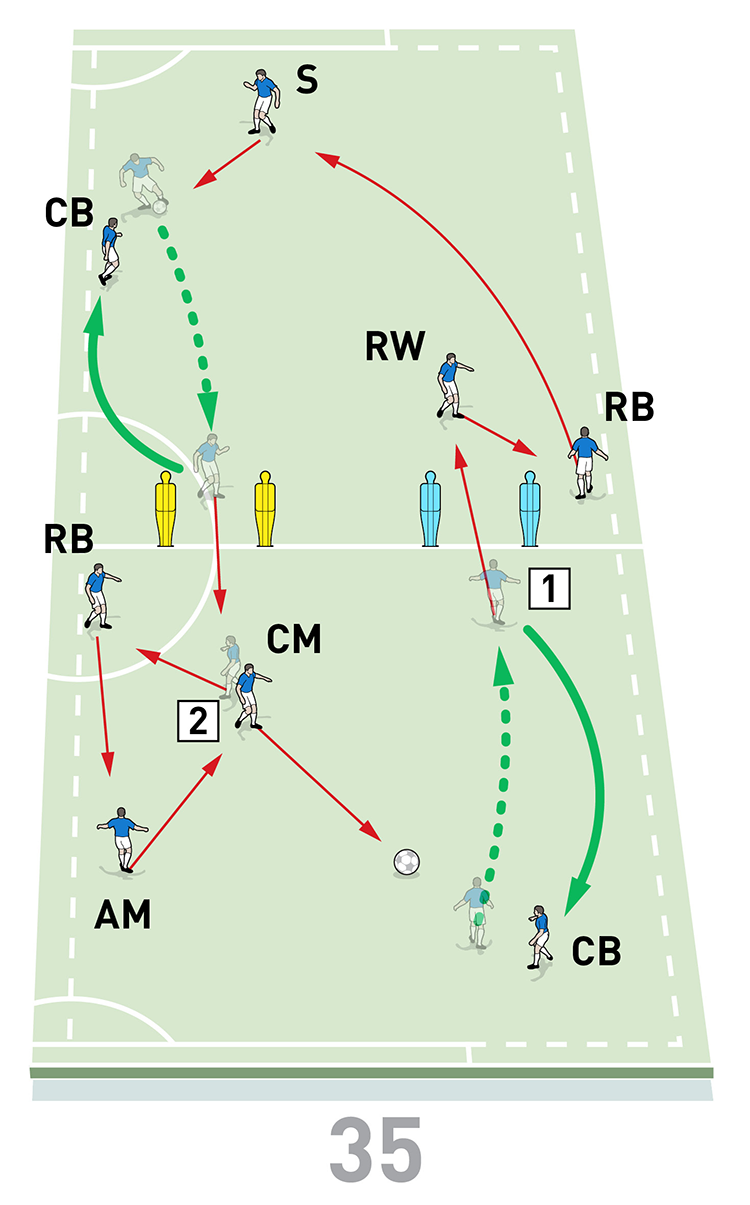
2. Play follows this pattern until the centre midfielder returns the ball to the starting centre back and then the same sequence is repeated
1. The centre back (CB) drives up the pitch with the ball to just behind the mannequins and passes to the right winger (RW).
2. The right winger (RW) passes outside to the right back (RB), who moves forward to receive the ball.
3. The right back (RB) passes to striker (S) who moves forward to receive and passes down to the other centre back (CB).
4. The centre back (CB) drives down the pitch and passes through the mannequins to the centre midfielder (CM).
5. The centre midfielder (CM) passes outside to the other right back (RB), who passes forward to the attacking midfielder (AM).
6. The centre midfielder (CM) turns and the attacking midfielder (AM) lays the ball to him. The centre midfielder (CM) then passes to the starting centre back (CB).
What are the key things to look out for?
We want to see accurate short, and medium, passes. Rhythm and timing of the movement, together with the accuracy and weight of pass, are key, as are players adopting the correct body shape to receive the ball. We want to see this performed at a high tempo.
We set up an area of 60x50 yards divided into three equal zones. We’re using 20 outfield players and two goalkeepers, who are positioned at either end and who are support players for both teams. We’re using 20 outfield players split into two teams of 10. Both teams are set up in a 3-4-3 formation, with three defenders in the defensive zone, two central midfielders and two wingers in the central zone, and three forwards in the offensive zone, as shown [2a].
2a

2. Both teams are set-up in a 3-4-3. The possession team can move freely but the defending team (the blues) can only defend in their own zones
3. The aim is to play through all zones until the ball reaches the keeper at the opposite end. Then the ball should be worked back
4. The blues press and if they win the ball they pass to the nearest keeper and become the possession team and try to work the ball to the opposite keeper
Players on the attacking team can move freely to create a numerical superiority, but players on the defending team can only defend in their own zones.
Play starts with a goalkeeper passing to a defender in the defensive zone. The aim is to pass through all the zones until the ball reaches the goalkeeper at the opposite end and then the ball should be worked back to the initial goalkeeper. Whenever a team succeeds, it gains a point and keeps possession. The opposition team press to win the ball and if they gain possession they must pass to the nearest keeper and then try to work the ball through the zones to get it from one end to the other for a point. The practice is continuous.
We can progress this activity by increasing the length of the playing area and setting up between the six-yard lines of a pitch, with goals at both ends. We divide the area between the penalty boxes evenly into three zones. The aim of the practice changes as now teams must play through the zones from end to end, finishing with a shot on goal instead of a pass to the keeper, as shown [2b].
2b
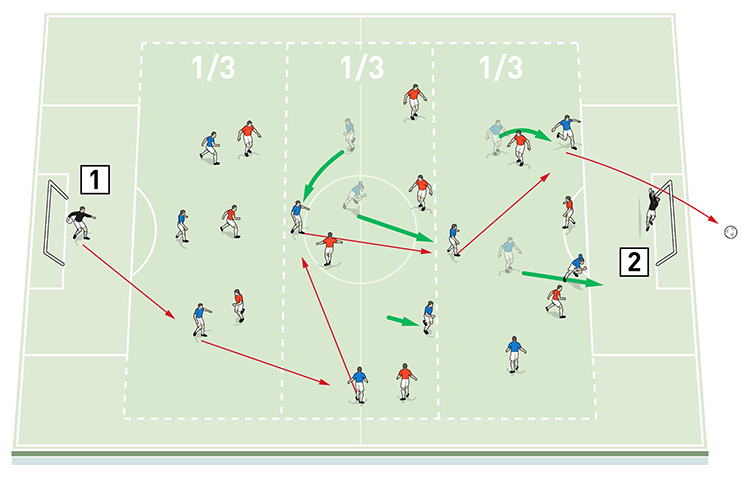
2. The aim should now be to play through the zones, finishing with a shot on goal instead of a pass to the keeper
What are the key things to look out for?
We want to see players moving the ball quickly and wisely in order to disorganise the opposition, preferably when playing forward. We also want to see players supporting their team mates in the next zone by making fast forward runs to receive a one touch pass back if necessary, as this makes it much easier to maintain the possession of the ball and progress through the zones.
THEMATIC GAME
We set up a playing area on three quarters of the pitch, between the 18-yard line at one end and the opposite end line. We position a goal and a goalkeeper at each end. We also mark a line seven yards from the halfway line. We’re using 20 outfield players split into two teams of 10.
Play starts with a pass out from the keeper of the team at the short end (the reds). They are the attacking team and they are set up in a 3-4-3 formation. They build up play from the back, trying to score using smart possession to unbalance the defensive organisation of their opponents and using space to create scoring opportunities, as shown [3a].
3a
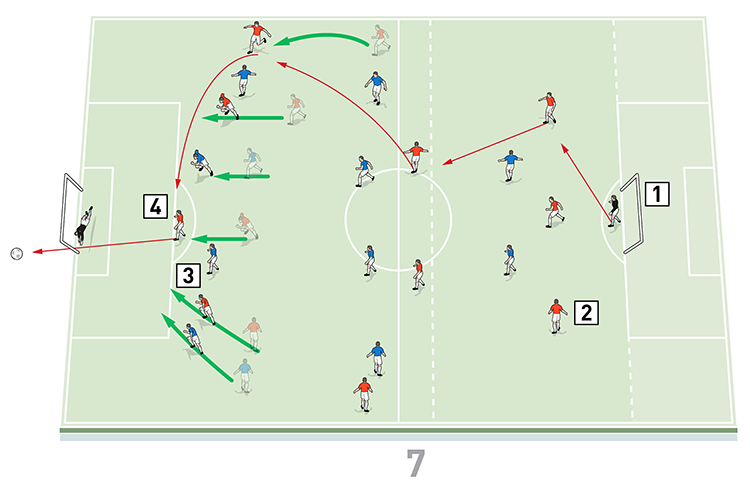
2. Behind the dashed line the reds can only play with three defenders but the entire team can attack when the ball is on the other side of the line
3. The blues are the 4-4-2 defending team. When the ball is behind the dashed line, they can defend with eight, but when it’s in front of it they can only defend from the front with three forwards
4. When the ball goes out of play, or if one team scores, play restarts from the red attacking team’s keeper
Behind the dashed line the reds can only play with three defenders but the entire team can attack when the ball is on the other side of the line.
However, if they move forward the defenders must remain aware and they must not forget to readjust their position in order to balance the team defensively when in the offensive phase.
The blues are the defending team and they are defending the long end, set up in a 4-4-2 formation. They seek to prevent their opponents scoring and must try to recover the ball. In front of the dashed line the blues can only defend from the front with three forward players (two strikers and one winger), but behind the dashed line they can defend with eight (four midfielders and four defenders).
If they gain possession, the blues must get the ball to their strikers quickly and try to score through a counter-attack or a fast attack, as shown [3b]. If they manage to cross the dashed line, the blues can attack with four, making it a 4v3 attack because the reds can only defend with three.
3b
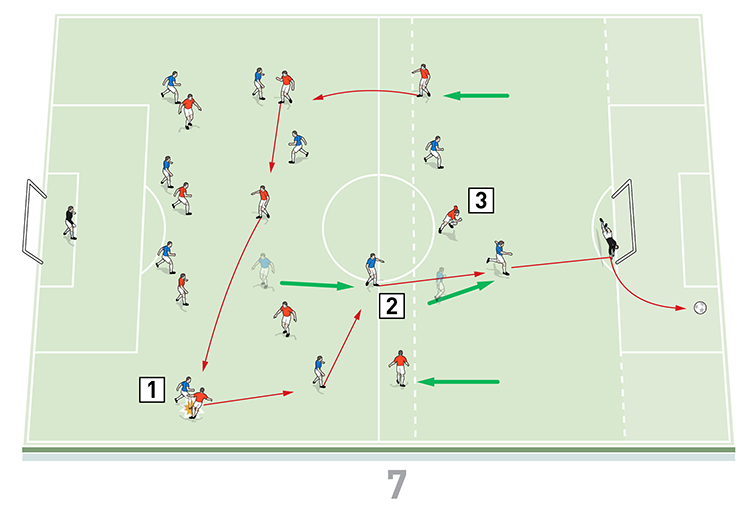
2. If the blues get the ball across the dashed line, they can attack with up to four players
3. As the reds can only defend behind the dashed line with three players, this makes the attack potentially 4v3 if the players recover quick enough
If the ball goes out of play, or if one team scores, restart the practice with the attacking team’s keeper.
What are the key things to look out for?
We want to see the red attacking team using good positioning to receive between the lines and making well-timed movements. They should also quickly switch the play to attack the weak side with a numerical advantage. For this we want to see good timing and quick forward movement from the players coming from behind.
When the attacking teams loses possession of the ball, the nearest player must immediately press the new ball carrier to stop him passing or dribbling forwards and forcing him to play under pressure; also important is fast support by team mates to mark the players tightly around the ball zone and block off potential passing lines, creating a numerical advantage around the ball.
The attacking team’s defenders must be able to read the tactical situation and collectively converge to mark the forwards closely, in order to block off possible passes towards them, or in case the ball is uncovered, quickly lower their position to remove the possibility of the opponent taking advantage of the space behind.
We want to see the blue defending team playing according to the characteristics of our next opponents, in general lining up in a 4-4-2 formation, with its defensive block positioned at the entrance of its defensive midfield and trying to reach the goal through fast and direct attacks.
11v11 GAME
We set up a playing area on three quarters of the pitch, between the 18-yard line at one end and the opposite end line. We position a full size goal and a goalkeeper at each end.
We set up and coach the reds in a 3-4-3 formation and the blues set up in a 4-4-2 formation. The blues should be encouraged to replicate as closely as possible the characteristics of our opponents for the next game, both offensively and defensively.
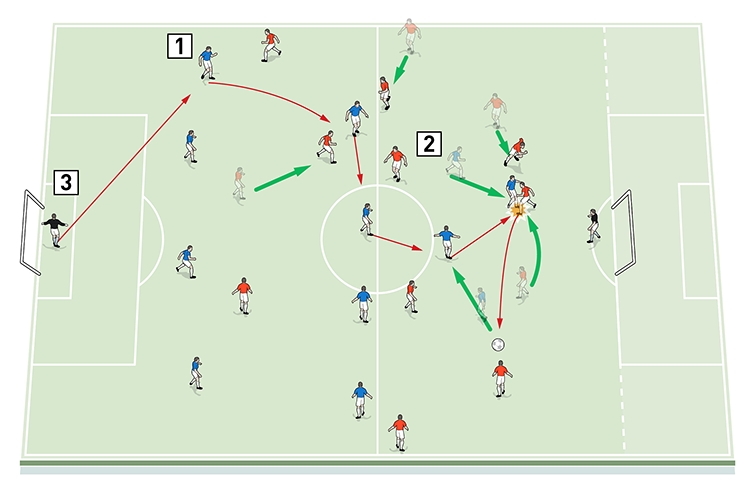
2. The red team is set up in a 3-4-3 formation
3. Play a normal game. If the ball goes out of play at one end, or if one team scores, the game is always restarted by a goalkeeper selected by the coach. There are no corner kicks
We play a normal game with certain conditions. If the ball goes out of play on the sides, restart with a throw-in as normal but if the ball goes out of play at one end, or if one of the teams scores a goal, the game is always restarted by the goalkeeper selected by the coach in order to fulfil the objectives. There are no corner kicks.
Related Files
Editor's Picks
Deep runs in the final third
Using the goalkeeper in build-up play
Pressing principles
Intensive boxes drill with goals
Penetrating the final third
Creating and finishing
My philosophy
Pressing initiation
Compact team movement
Coaches' Testimonials

Alan Pardew

Arsène Wenger

Brendan Rodgers

Carlos Carvalhal

José Mourinho

Jürgen Klopp

Pep Guardiola

Roy Hodgson

Sir Alex Ferguson

Steven Gerrard
Coaches' Testimonials

Gerald Kearney, Downtown Las Vegas Soccer Club

Paul Butler, Florida, USA

Rick Shields, Springboro, USA

Tony Green, Pierrefonds Titans, Quebec, Canada
Join the world's leading coaches and managers and discover for yourself one of the best kept secrets in coaching. No other training tool on the planet is written or read by the calibre of names you’ll find in Elite Soccer.
In a recent survey 92% of subscribers said Elite Soccer makes them more confident, 89% said it makes them a more effective coach and 91% said it makes them more inspired.
Get Monthly Inspiration
All the latest techniques and approaches
Since 2010 Elite Soccer has given subscribers exclusive insight into the training ground practices of the world’s best coaches. Published in partnership with the League Managers Association we have unparalleled access to the leading lights in the English leagues, as well as a host of international managers.
Elite Soccer exclusively features sessions written by the coaches themselves. There are no observed sessions and no sessions “in the style of”, just first-hand advice delivered direct to you from the coach.








